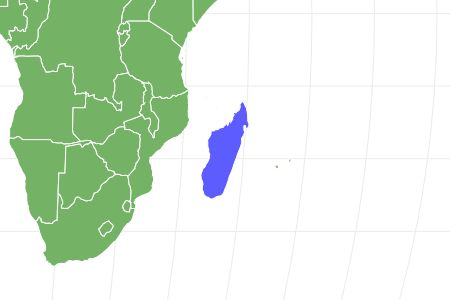Achrioptera Manga
Achrioptera manga
Unlike other species of stick insects, the Achrioptera manga's mating season is year-round and mating occurs regularly.
Advertisement
Achrioptera Manga Scientific Classification
- Kingdom
- Animalia
- Phylum
- Arthropoda
- Class
- Insecta
- Order
- Phasmatodea
- Family
- Phasmatidae
- Genus
- Achrioptera
- Scientific Name
- Achrioptera manga
Read our Complete Guide to Classification of Animals.
Achrioptera Manga Conservation Status
Achrioptera Manga Facts
- Group Behavior
- Solitary
- Fun Fact
- Unlike other species of stick insects, the Achrioptera manga's mating season is year-round and mating occurs regularly.
- Most Distinctive Feature
- Bright blue coloring of males
Achrioptera Manga Physical Characteristics
- Color
- Brown
- Blue
- Skin Type
- Exoskeleton
- Lifespan
- Several months
- Length
- 5.2-9.1 in
- Age of Sexual Maturity
- 4-6 months
- Venomous
- No
- Aggression
- Low
View all of the Achrioptera Manga images!
This stick insect has an extremely small range and only lives in very small parts of dry deciduous forests in Madagascar.
Achrioptera manga is a species of phasmid, also known as stick insects. These insects camouflage themselves by looking like sticks and leaves. Like many related insects, they can regrow their limbs through regeneration. This species is only found in a few forests in northern Madagascar, making them one of the rarest stick insects out there.
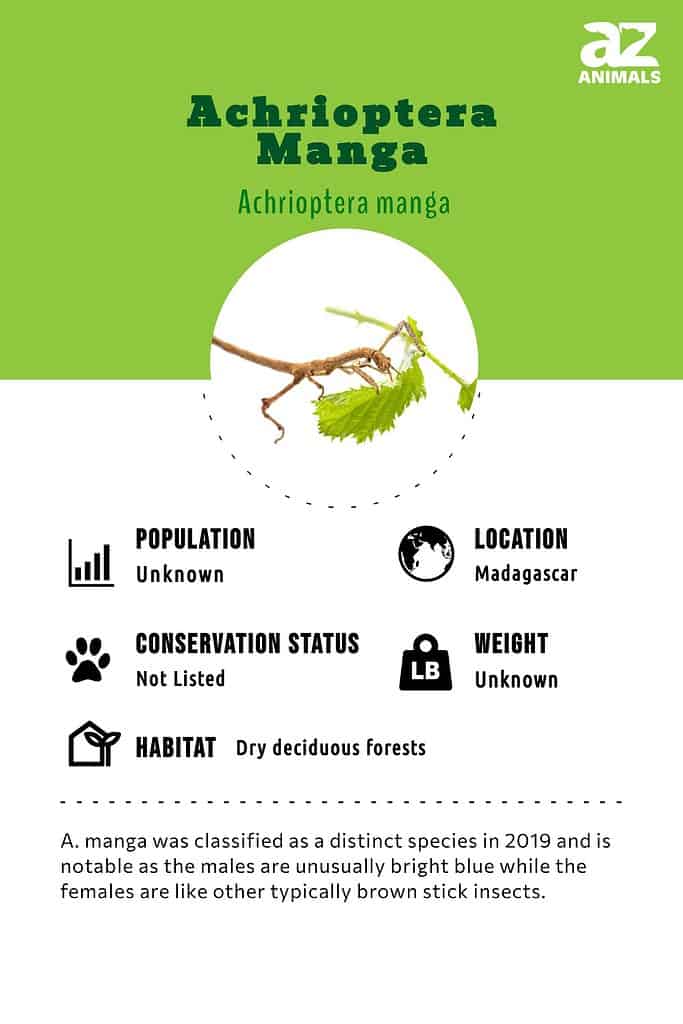
4 Amazing Facts About the Achrioptera Manga!
- A. manga is only found in very specific areas in Madagascar.
- Despite the males being brightly colored, this stick insect mimics branches and twigs quite well.
- This genus this species belongs to was described in 1861 but specimens of A. manga were only first collected in 2007.
- Not much is known for sure about A. manga since scientists only recently classified it as a separate species. Much of what we know is assumed based on related insects.

is found only in forests in northern Madagascar.
©Millenius/Shutterstock.com
Scientific Name
The scientific name Achrioptera manga includes the Malagasy word for “blue” in reference to the male’s coloring. The A. manga belongs to the genus of Achrioptera. You can find this genus in some areas of Africa, including Madagascar. All members of this family have bright colors, though they can still blend into their environment.
It does not have a common name but it, along with another similar and recently identified species in the genus Achrioptera, is often grouped as Malagasy Giant Stick Insects.
Evolution and Origins
Specimens of these insects were first collected in 2007. Prior to 2019, scientists classified the Achrioptera manga as Achrioptera fallax, a different species with a similar appearance. Both species in the genus Achrioptera differ from other stick insects in the males’ bright coloring, but while A. manga is blue, A. fallax is green.
A. manga belongs to the Phasmatidae family, which contains some of the largest insects on the planet, and is part of the Phasmatodea order. An extinct superfamily of Phasmatodea called Susumanioidea was present during the Middle Jurassic 174.1 million years to 163.5 million years ago. The earliest fossil evidence of a leaf insect is Eophyllium messelensis, found in Germany dating back 47 million years to the Eocene Epoch.

belongs to the Phasmatodea family of stick insects.
©Al’fred/Shutterstock.com
Appearance
Often, humans find these insects bizarre and even threatening. However, stick insects pose no threat to humans.
The males can reach 5.2-5.7 inches in length, while females are larger with wider bodies and typically reach 7.9-9.1 inches long on average.
The males of this species are a bright blue color, although they are still capable of blending into their surroundings and can hide from potential predators. Females have brown colorations, allowing them to blend in more with their environment.
Another difference between the males and females in appearance is that while both have sharp spines on their legs and thoraxes, the males usually also have spines on their heads, and females only sometimes do.
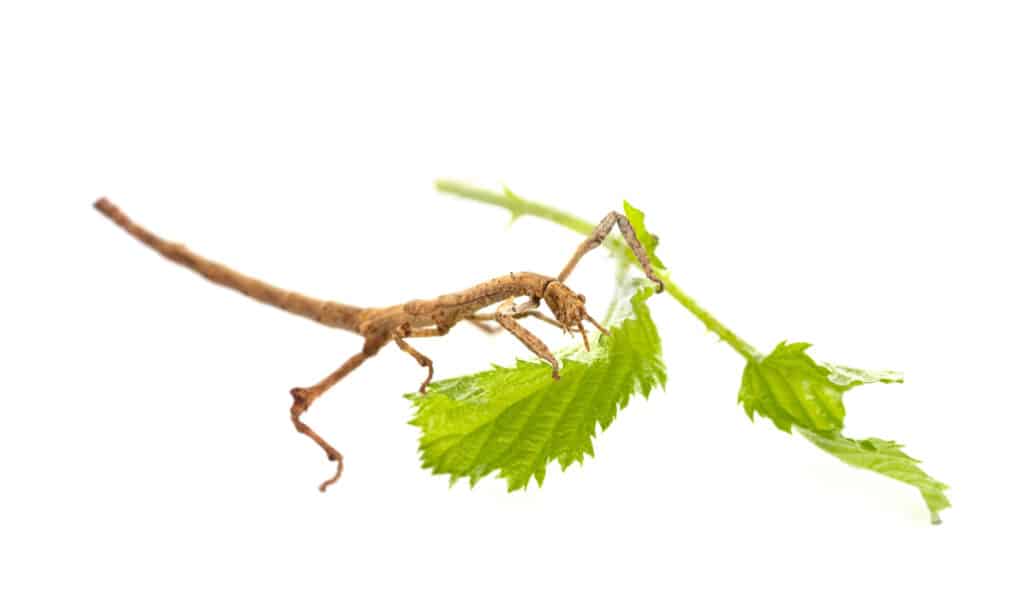
females are brown and can easily blend in with their environment.
©cynoclub/Shutterstock.com
Behavior
These insects are mainly active during the day and especially when it is windy for reasons unknown.
Their wings do not allow them to fly but when they are startled or threatened, they rub their second pair of wings together to create a rustling or buzzing noise and can try to pinch their hindlegs to trap a potential predator. It’s possible that the males’ blue coloring is also meant to ward off predators as it could suggest toxicity in the wild. Their neck glands emit repellent substances as a defense mechanism against potential predators.
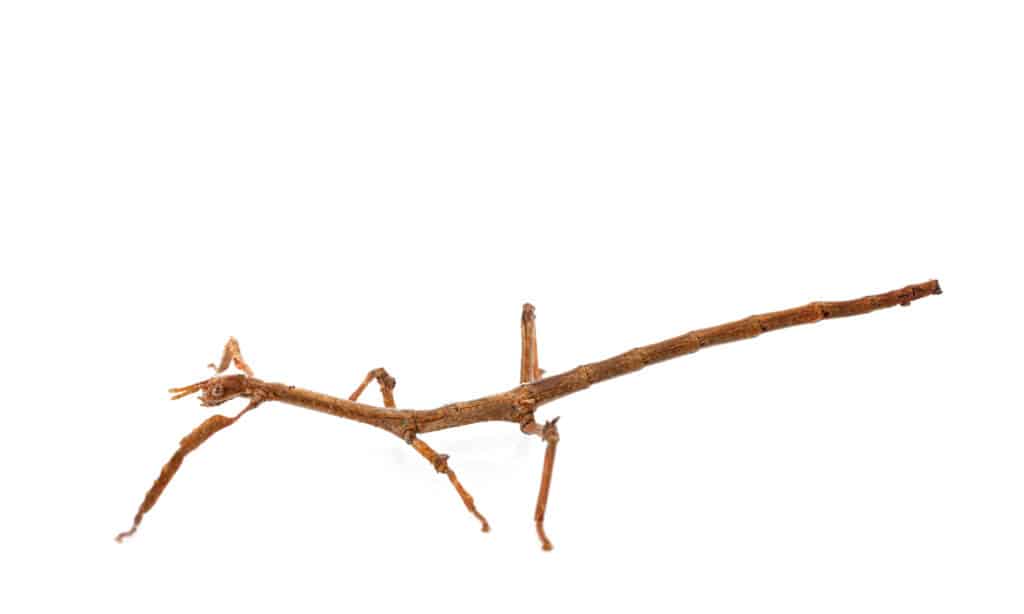
are mostly active during the day.
©cynoclub/Shutterstock.com
Habitat
This insect has an extremely small range. As far as experts can tell, they only live in very small parts of dry deciduous forests in northern Madagascar, including Montagne des Français and Foret d’Orangea. This species has yet to be studied in-depth so their exact range remains unknown.
However, this species appears to live in similar habitats to other stick insects. Largely, they stay in the trees and on shrubs, which allows them to blend into their surroundings.

makes its home in dry, deciduous forests in Madagascar.
©Hyotographics/Shutterstock.com
Diet
No one has studied this insect in-depth to understand exactly what it eats. However, it remains likely that it is herbivorous and consumes solely the leaves of the surrounding trees, like other stick insects.
The northern forests of Madagascar have many different tree species that this insect could consume. While this species could rely solely on one species of tree for their diet, experts expect that they consume a range of plants.
A. manga has been observed in captivity to eat leaves from plants such as salal, bramble, eucalyptus, oak, and raspberry. Adult females seem to prefer drier leaves to fresh foliage.
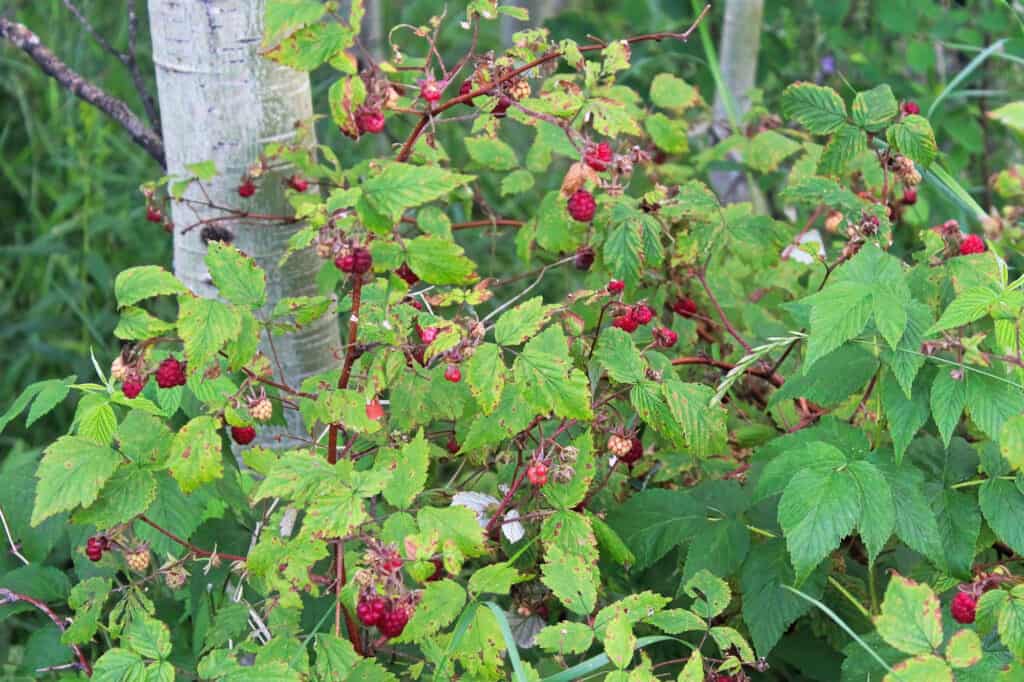
has been observed to eat raspberry leaves in captivity.
©Amelia Martin/Shutterstock.com
Predators and Threats
There is limited data available on A. manga, however, it could be suggested that this species faces some of the same threats that others with restricted ranges do. These could include humans putting the population at risk through actions leading to habitat loss and climate change bringing about negative environmental impact. However, as some of the northern forests became protected around 2016, heavy logging is no longer a threat to these habitats.
Reproduction, Babies, and Lifespan
Unlike other species of stick insects, the Achrioptera manga’s mating season is year-round and mating occurs regularly. Males will only initiate mating efforts once they gain their blue coloring, indicating it may be to help them attract females. Following mating, the male stays with the female for a few days, and after the female lays around 40-50 eggs, she moves them to foliage with her abdomen.
The incubation period is for 4-5 months and males gain their blue coloring within a week of hatching. Males reach maturity at around 4-5 months and females are mature at 5-6 months.
The lifespan of the A. manga is believed to be about several months.
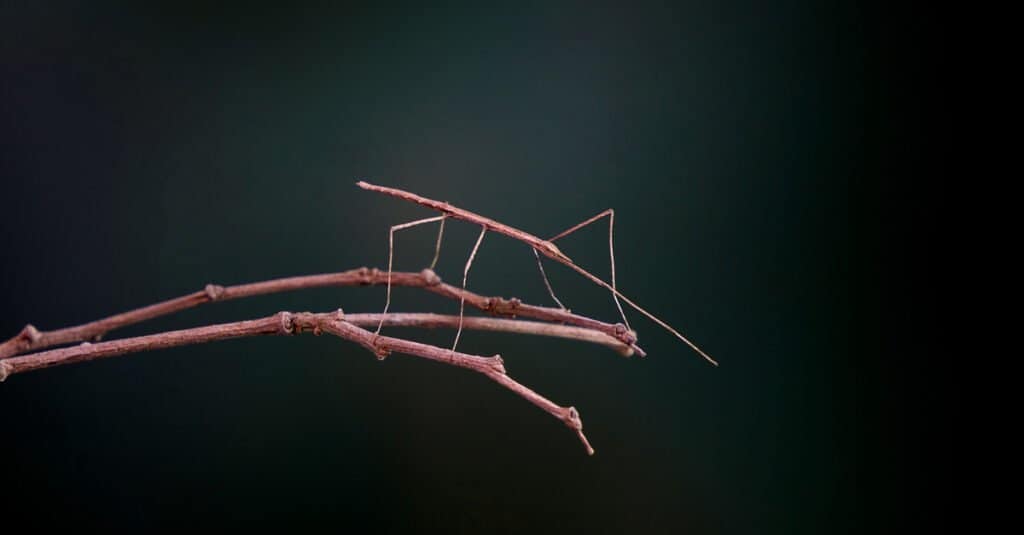
Unlike other stick insects, the
A. manga‘s mating season is year-round.
©Mark Brandon/Shutterstock.com
Population and Conservation
This species is not currently classified by the International Union for Conservation of Nature, and its conservation status is unknown.
The number of these insects in the wild is also unknown. This species is becoming more available as a pet so this may assist in growing numbers. It’s possible that as it is only found in a number of habitats in Madagascar, further research into the Achrioptera manga may show that its population is at risk.
View all 192 animals that start with AAchrioptera Manga FAQs (Frequently Asked Questions)
Are Achrioptera manga dangerous?
This stick insect may look quite dangerous. Plus, they are brightly colored, which makes them look potentially poisonous. However, humans have nothing to fear from this insect. They remain completely harmless, just like any other stick insect.
Their bright coloration probably signals their mating capacity. In this way, this insect species gets its color for the same reason a peacock does. By being brightly colorful, the insect signals to potential mates that they don’t have to hide.
Are Achrioptera manga helpful or harmful?
We don’t know much about how these insects interact with their environment. However, they likely consume massive amounts of leaves, just like other stick insects. For this reason, scientists expect that they are a dominant light gap producer.
These light gaps provide light to smaller plants below and encourage new plants to grow. Therefore, this insect likely plays a crucial role in their forest.
Can I hold an Achrioptera manga?
If you could find one, you could hold one of these bugs without a significant problem. Scientists haven’t found these bugs to be poisonous or harmful. Therefore, you could hold one without worrying about getting hurt.
However, these bugs are extremely fragile. They can regrow their limbs, so their extremities don’t tend to be as durable as other animals.
Thank you for reading! Have some feedback for us? Contact the AZ Animals editorial team.

